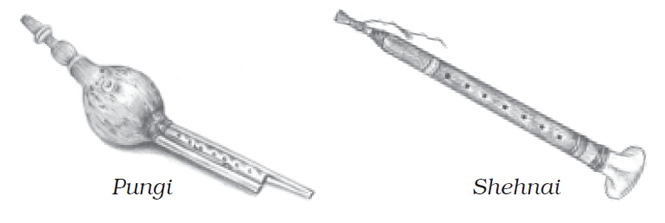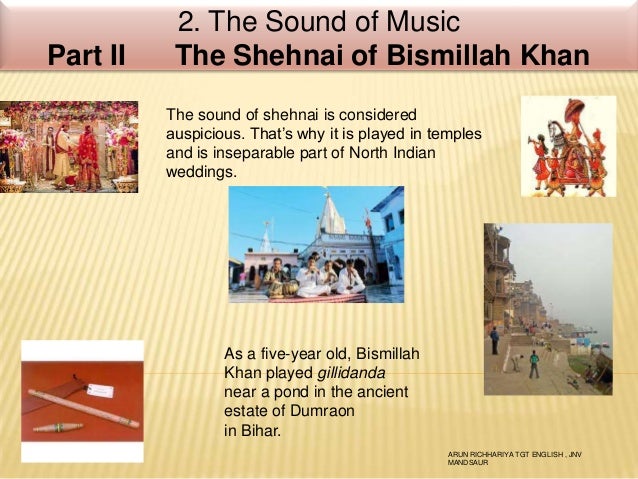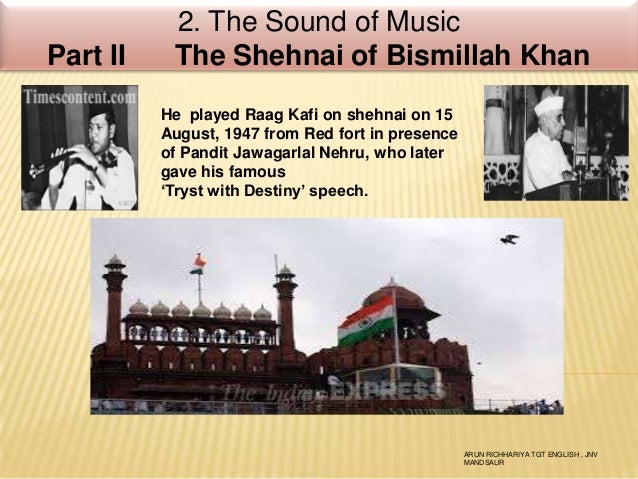About the Poet Ustaad Bismillah Khan
Ustad Qamruddin “Bismillah” Khan, often referred to by the title Ustad, was an Indian musician credited with popularizing the shehnai, a subcontinental wind instrument of the oboe class. Bismillah accompanied his uncle to the Allahabad Music Conference. When Bismillah Khan was 14 years of age, he accompanied his maternal uncle, Ali Bux to the Allahabad Music Conference.

| Poet Name | Ustaad Bismillah Khan |
| Born | 21 March 1916, Dumraon |
| Died | 21 August 2006, Heritage Hospitals, Varanasi |
| Instrument | Shehnai |
| Awards | Bharat Ratna, Padma Vibhushan, Padma Bhushan, Padmashri |

It was Bismillah Khan who popularized shehnai and took it to the world stage. He broke the myth of shehnai not being capable to create independent tunes. He came from a family of musicians

As a five-year old, Bismillah Khan would go regularly to the nearby Bihariji temple to sing the Bhojpuri 'Chaita' , at the end of which earn a big laddu weighing 1.25 kg,a prize given by the local Maharaja.
So the young boy took to music early in life. He started accompanying his uncle,Ali Bux, to the Vishnu temple of Benaras where Bux was employed to play shehnai and Bismillah would sit watching him for hours .Slowly , he started getting lessons in playing shehnai and would sit practising throughout the day. The flowing waters of Ganga inspired him to invent ragas that were earlier considered beyond the range of the shehnai.
After achieving immense success, he was awarded various titles. He is also a recipient of the highest civilian award of India- The Bharat Ratna.

In addition to that, he has won all three awards of Padma Bhushan, Padmashree and Padma Vibhushan. Interestingly, he was the first person to be invited to play shehnai at the Red Fort in 1947, while greeting Independent India.

Most importantly, he represented India on the international stage as well. An auditorium in Tehran is also by his name. Moreover, despite many opportunities, Bismillah Khan never left his home-town Varanasi. He dedicated his life to music and passed away in 2006.
कवि उस्ताद बिस्मिल्लाह खान के बारे में उस्ताद क़मरुद्दीन "बिस्मिल्लाह" खान, जिन्हें अक्सर उस्ताद
शीर्षक से संदर्भित किया जाता था, एक भारतीय संगीतकार थे, जिन्हें ओबनी वर्ग के एक
उपमहाद्वीपीय पवन उपकरण शहनाई को लोकप्रिय बनाने का श्रेय दिया जाता था। बिस्मिल्लाह अपने
चाचा के साथ इलाहाबाद संगीत सम्मेलन में आए। जब बिस्मिल्लाह खान 14 साल के थे, तब वह
अपने मामा, अली बक्स के साथ इलाहाबाद संगीत सम्मेलन में भाग लेने आए थे। उस्ताद बिस्मिल्लाह
खान - बिस्मिल्लाह खान कक्षा 9 सारांश की शहनाई कवि का नाम उस्ताद बिस्मिल्ला खान जन्म 21
मार्च 1916, डुमरांव 21 अगस्त 2006 को निधन, हेरिटेज अस्पताल, वाराणसी साधन शहनाई भारत
रत्न, पद्म विभूषण, पद्म भूषण, पद्मश्री मुगल सम्राट औरंगजेब ने अपने शाही दरबार में पुंगी के खेलने
पर प्रतिबंध लगा दिया। उन्होंने ध्वनि को नापसंद किया और इसलिए, पुंगी को एक नीमहकीम कहा
गया। एक नाई ने पुंगी के स्वर को सुधारने की कोशिश की। उन्हें एक खोखला तना मिला, जो पुंगी से
अधिक चौड़ा और लंबा था, इस पर सात छेद किए और छेद को बंद करके उसे खोल दिया। इसने
नरम, मधुर संगीत का उत्पादन किया। चूंकि इस उपकरण को भारत में 'नाई' नामक एक नाई द्वारा
विकसित किया गया था और इसे राजा के दरबार में the शाह ’कहा जाता था, इस उपकरण का नाम
developed शहनाई’ था। शहनाई शुभ अवसरों का एक हिस्सा बन गई। यह नौ संगीत वाद्ययंत्रों के
समूह का एक हिस्सा था जो शाही दरबार में बजाया जाता था। यह बिस्मिल्लाह खान थे जिन्होंने
शहनाई को लोकप्रिय बनाया और इसे विश्व मंच पर ले गए। उन्होंने शहनाई के उस मिथक को तोड़ा
जो स्वतंत्र धुनों को बनाने में सक्षम नहीं था। वह संगीतकारों के एक परिवार से आया था 9 संगीत भाग
ii की ध्वनि - बिस्मिल्लाह खान की शहनाई पांच साल की उम्र में, बिस्मिल्लाह खान नियमित रूप से
भोजपुरी 'चैता' गाने के लिए पास के बिहारीजी मंदिर जाते थे, जिसके अंत में स्थानीय महाराज द्वारा
दिए गए पुरस्कार के रूप में 1.25 किलो वजन का एक बड़ा लड्डू कमाते थे। इसलिए युवा लड़के ने
जीवन में शुरुआती संगीत लिया। वह अपने चाचा अली बक्स के साथ बनारस के विष्णु मंदिर में जाने
लगे, जहाँ बक्स को शहनाई बजाने के लिए काम पर रखा गया था और बिस्मिल्लाह उन्हें घंटों देखता
रहता था। इसके अलावा, उन्हें शहनाई बजाने का पाठ मिलना शुरू हो गया और वे पूरे दिन अभ्यास
करते रहेंगे। गंगा के बहते पानी ने उन्हें रागों का आविष्कार करने के लिए प्रेरित किया जो पहले
शहनाई की
सीमा से परे माना जाता था।
अपार सफलता प्राप्त करने के बाद, उन्हें विभिन्न उपाधियों से सम्मानित किया गया। वह भारत के सर्वोच्च नागरिक पुरस्कार- द भारत रत्न से भी सम्मानित हैं।इसके अलावा, उन्होंने पद्म भूषण, पद्मश्री और पद्म विभूषण के तीनों पुरस्कार जीते हैं। दिलचस्प बात यह है कि, वह पहला व्यक्ति था जिसने 1947 में लाल किले पर शहनाई बजाने के लिए आमंत्रित किया, जबकि स्वतंत्र भारत का अभिवादन किया।
सबसे महत्वपूर्ण बात, उन्होंने अंतर्राष्ट्रीय मंच पर भी भारत का प्रतिनिधित्व किया। तेहरान में एक सभागार भी उनके नाम से है। इसके अलावा, कई अवसरों के बावजूद, बिस्मिल्लाह खान ने कभी अपने घर-शहर वाराणसी को नहीं छोड़ा। उन्होंने अपना जीवन संगीत को समर्पित कर दिया और 2006 में उनका निधन हो गया।
Answer these questions :
1. Why did Aurangzeb ban the playing of the pungi?
A. Aurangzeb disliked the sound produced by the pungi. It was considered to be a reeded noisemaker as it was loud, shrill and unpleasant. So, he banned playing of pungi in his royal court.
2. How is a shehnai different from a pungi?
A. Although the shehnai is also a reeded musical instrument like the pungi, it differs in shape, size and the quality of sound produced by it. It was made with a hollow stem which was longer and broader than the pungi and had seven holes on it. The sound produced by the shehnai was soft and melodious in contrast to the shrill noise made by the pungi.
3. Where was the shehnai played traditionally? How did Bismillah Khan change this?
A. Traditionally, the shehnai was played at the royal court as part of the traditional collection of musical instruments called ‘naubat’, in the temples and at weddings. Bismillah Khan invented new ragas with the shehnai and thus, brought it on the stage among other classical musical instruments.
4. When and how did Bismillah Khan get his big break?
A. Bismillah Khan got his big break when in 1938 the All India Radio opened its Radio Station at Lucknow. He played shehnai from the radio station regularly and his music became popular through it.
5. Where did Bismillah Khan play the shehnai on 15 August 1947? Why was the event historic?
On 15th August 1947, Bismillah Khan played the shehnai from the Red Fort and greeted the entire country. The event was historic as it was the day when India gained independence from the British rule. Bismillah’s performance was followed by the historic speech – ‘Tryst with Destiny’ given by India’s first Prime Minister – Pandit Jawaharlal Nehru.
6. Why did Bismillah Khan refuse to start a shehnai school in the U.S.A.?
A. Bismillah Khan was attached to the temples of Benaras and the river Ganga. He could not leave them and so, refused to set up a shehnai school in the USA.
7. Find at least two instances in the text which tell you that Bismillah Khan
loves India and Benaras.
A. Bismillah’s love for India and Benaras are shown by the fact that he refused to set up a shehnai school in USA as he could not leave Benaras and river Ganga. Secondly, when he was honoured with the Bharat Ratna, he declared that Indian Classical music was India’s richest heritage.
Mam very nice
ReplyDeleteInteresting......
ReplyDeleteThanks ma'am for this.It's helpful to us.
ReplyDeleteThanks mam it is very helpful to us
ReplyDeleteWow! it's wonderful
ReplyDeleteBest,💯👍👍
ReplyDelete